.gif)
Lamb (food)
Encyclopedia
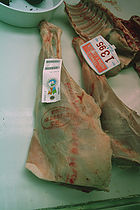
Domestic sheep
Sheep are quadrupedal, ruminant mammals typically kept as livestock. Like all ruminants, sheep are members of the order Artiodactyla, the even-toed ungulates. Although the name "sheep" applies to many species in the genus Ovis, in everyday usage it almost always refers to Ovis aries...
. The meat of a sheep in its first year is lamb; that of a juvenile sheep older than 1 year is hogget; and the meat of an adult sheep is mutton.
Distinct from the meat, a lamb (with the indefinite article) also describes a live juvenile sheep (species Ovis aries), which may or may not be used for its meat. In Australia, the term prime lamb is often used to refer to lambs raised for meat.
Classifications and nomenclature
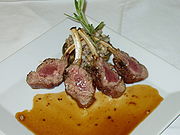
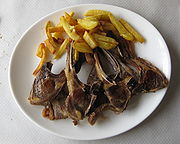
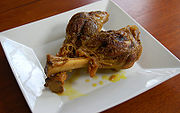
New Zealand
New Zealand is an island country in the south-western Pacific Ocean comprising two main landmasses and numerous smaller islands. The country is situated some east of Australia across the Tasman Sea, and roughly south of the Pacific island nations of New Caledonia, Fiji, and Tonga...
for example, they are defined as follows:
- Lamb — a young sheep under 12 months of age which does not have any permanent incisor teeth in wear
- Hogget — a sheep of either sex having no more than two permanent incisors in wear
- Mutton — a female (ewe) or castrated male (wether) sheep having more than two permanent incisors in wear.
In Australia
Australia
Australia , officially the Commonwealth of Australia, is a country in the Southern Hemisphere comprising the mainland of the Australian continent, the island of Tasmania, and numerous smaller islands in the Indian and Pacific Oceans. It is the world's sixth-largest country by total area...
the definitions are extended to include ewes and rams, as well as being stricter on the definition for lamb which is:
- Lamb — 0 permanent incisors; female or castrate entire male ovine 0–12 months (note that the Australian definition requires 0 permanent incisors, whereas the New Zealand definition allows 0 incisors 'in wear'.)
Under current United States federal regulations, only the term 'lamb' is used:
- Lamb — ovine animals of any age, including ewes and rams
The term 'mutton' is rare, and 'hogget' unknown, in the United States.
Younger lambs are smaller and more tender. Mutton is meat from a sheep over two years old, and has a less tender flesh. In general, the darker the colour, the older the animal. Baby lamb meat will be pale pink, while regular lamb is pinkish-red.
Other definitions include:
- Lamb — a young sheep that is less than one year old
- Baby lamb — a milk-fed lamb between six and eight weeks old
- Spring lamb — a milk-fed lamb, usually three to five months old, born in late winter or early spring and sold usually before July 1
- Yearling lamb — a young sheep between 12 and 24 months old.
- Milk-fed lamb — meat from an unweaned lamb, typically 4 to 6 weeks old and weighing 5.5 to 8 kgKilogramThe kilogram or kilogramme , also known as the kilo, is the base unit of mass in the International System of Units and is defined as being equal to the mass of the International Prototype Kilogram , which is almost exactly equal to the mass of one liter of water...
; this is almost unavailable in countries such as the USAUnited StatesThe United States of America is a federal constitutional republic comprising fifty states and a federal district...
and the UKUnited KingdomThe United Kingdom of Great Britain and Northern IrelandIn the United Kingdom and Dependencies, other languages have been officially recognised as legitimate autochthonous languages under the European Charter for Regional or Minority Languages...
, where it is considered uneconomic. The flavour and texture of milk-fed lamb when grilled (such as the tiny lamb chopMeat chopA meat chop is a cut of meat cut perpendicularly to the spine, and usually containing a rib or riblet part of a vertebra and served as an individual portion. The most common kinds of meat chops are pork and lamb. A thin boneless chop, or one with only the rib bone, may be called a cutlet, though...
s known as chuletillas in SpainSpainSpain , officially the Kingdom of Spain languages]] under the European Charter for Regional or Minority Languages. In each of these, Spain's official name is as follows:;;;;;;), is a country and member state of the European Union located in southwestern Europe on the Iberian Peninsula...
) or roasted (lechazo asado or cordero lechal asado) is generally thought to be finer than that of older lamb. The areas in northern Spain where this can be found include AsturiasAsturiasThe Principality of Asturias is an autonomous community of the Kingdom of Spain, coextensive with the former Kingdom of Asturias in the Middle Ages...
, CantabriaCantabriaCantabria is a Spanish historical region and autonomous community with Santander as its capital city. It is bordered on the east by the Basque Autonomous Community , on the south by Castile and León , on the west by the Principality of Asturias, and on the north by the Cantabrian Sea.Cantabria...
, Castile and LeónCastile and LeónCastile and León is an autonomous community in north-western Spain. It was so constituted in 1983 and it comprises the historical regions of León and Old Castile...
, and La Rioja. Milk-fed lambs (and kidsGoatThe domestic goat is a subspecies of goat domesticated from the wild goat of southwest Asia and Eastern Europe. The goat is a member of the Bovidae family and is closely related to the sheep as both are in the goat-antelope subfamily Caprinae. There are over three hundred distinct breeds of...
) are especially prized for EasterEasterEaster is the central feast in the Christian liturgical year. According to the Canonical gospels, Jesus rose from the dead on the third day after his crucifixion. His resurrection is celebrated on Easter Day or Easter Sunday...
in GreeceGreeceGreece , officially the Hellenic Republic , and historically Hellas or the Republic of Greece in English, is a country in southeastern Europe....
, when they are roasted on a spit. - Sucker lambs — a term used in AustraliaAustraliaAustralia , officially the Commonwealth of Australia, is a country in the Southern Hemisphere comprising the mainland of the Australian continent, the island of Tasmania, and numerous smaller islands in the Indian and Pacific Oceans. It is the world's sixth-largest country by total area...
— includes young milk-fed lambs as well as slightly older lambs up to about 7 months of age which are also still dependent on their mothers for milk. Carcases from these lambs usually weigh between 14 and 30 kg. Older weaned lambs which have not yet matured to become mutton are known as old-season lambs. - Saltbush mutton - a term used in Australia for the meat of mature Merinos which have been allowed to graze on atriplexAtriplexAtriplex is a plant genus of 100-200 species, known by the common names of saltbush and orache . The genus is quite variable and widely distributed. It includes many desert and seashore plants and halophytes, as well as plants of moist environments...
plants. - Salt marsh lamb (also known as 'saltmarsh lamb' or by its French name, agneau de pré-saléAgneau de pré-saléAgneau de pré-salé is a type of lamb which was raised in salt marsh meadows of France, especially Normandy and Mont Saint-Michel. Considered a delicacy, it has a distinctive flavor due to the salinity of the pastures on which the sheep graze. Salt marsh lamb is also raised to a lesser extent in...
) — the meat of sheep which graze on salt marshSalt marshA salt marsh is an environment in the upper coastal intertidal zone between land and salt water or brackish water, it is dominated by dense stands of halophytic plants such as herbs, grasses, or low shrubs. These plants are terrestrial in origin and are essential to the stability of the salt marsh...
in coastal estuaries that are washed by the tides and support a range of salt-tolerant grasses and herbs such as samphireSamphireSamphire is a name given to a number of very different edible plants that happen to grow in coastal areas.*Rock samphire, Crithmum maritimum is a coastal species with white flowers that grows in the United Kingdom...
, sparta grass, sorrelSorrelCommon sorrel or garden sorrel , often simply called sorrel, is a perennial herb that is cultivated as a garden herb or leaf vegetable...
and sea lavender. Depending on where in the world the salt marsh is located, the nature of the plants may be subtly different. Salt marsh lamb has long been appreciated in FranceFranceThe French Republic , The French Republic , The French Republic , (commonly known as France , is a unitary semi-presidential republic in Western Europe with several overseas territories and islands located on other continents and in the Indian, Pacific, and Atlantic oceans. Metropolitan France...
and is growing in popularity in the United KingdomUnited KingdomThe United Kingdom of Great Britain and Northern IrelandIn the United Kingdom and Dependencies, other languages have been officially recognised as legitimate autochthonous languages under the European Charter for Regional or Minority Languages...
. Places where salt marsh lamb are reared in the UK include HarlechHarlechHarlech is a town and seaside resort in Gwynedd, within the historical boundaries of Merionethshire in northwest Wales. Lying on Tremadog Bay and within the Snowdonia National Park, it has a population of 1,952, of whom 59% speak Welsh...
and the Gower PeninsulaGower PeninsulaGower or the Gower Peninsula is a peninsula in south Wales, jutting from the coast into the Bristol Channel, and administratively part of the City and County of Swansea. Locally it is known as "Gower"...
in WalesWalesWales is a country that is part of the United Kingdom and the island of Great Britain, bordered by England to its east and the Atlantic Ocean and Irish Sea to its west. It has a population of three million, and a total area of 20,779 km²...
, the Somerset LevelsSomerset LevelsThe Somerset Levels, or the Somerset Levels and Moors as they are less commonly but more correctly known, is a sparsely populated coastal plain and wetland area of central Somerset, South West England, between the Quantock and Mendip Hills...
and Morecambe BayMorecambe BayMorecambe Bay is a large bay in northwest England, nearly due east of the Isle of Man and just to the south of the Lake District National Park. It is the largest expanse of intertidal mudflats and sand in the United Kingdom, covering a total area of 310 km².-Natural features:The rivers Leven,...
.
In many Eastern countries
Eastern world
__FORCETOC__The term Eastern world refers very broadly to the various cultures or social structures and philosophical systems of Eastern Asia or geographically the Eastern Culture...
including the Indian sub-continent, Malaysia and Singapore
Singapore
Singapore , officially the Republic of Singapore, is a Southeast Asian city-state off the southern tip of the Malay Peninsula, north of the equator. An island country made up of 63 islands, it is separated from Malaysia by the Straits of Johor to its north and from Indonesia's Riau Islands by the...
, the term mutton refers to goat
Goat
The domestic goat is a subspecies of goat domesticated from the wild goat of southwest Asia and Eastern Europe. The goat is a member of the Bovidae family and is closely related to the sheep as both are in the goat-antelope subfamily Caprinae. There are over three hundred distinct breeds of...
s' meat (which is properly called chevon) and usually not to sheep's meat. Often, the mutton curries of the Indian cuisine use goat meat when cooked at home.
Butchery and cookery
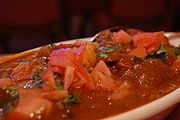
The meat of a lamb is taken from the animal between one month and one year old, with a carcase (carcass in American English) weight of between 5.5 and 30 kilograms (12 and 65 lbs). This meat generally is more tender than that from older sheep and appears more often on tables in some Western countries. Hogget and mutton have a stronger flavour than lamb because they contain a higher concentration of species-characteristic fatty acids and are preferred by some. Mutton and hogget also tend to be tougher than lamb (because of connective tissue maturation) and are therefore better suited to casserole
Casserole
A casserole, from the French for "saucepan", is a large, deep dish used both in the oven and as a serving vessel. The word casserole is also used for the food cooked and served in such a vessel, with the cookware itself called a casserole dish or casserole pan...
-style cooking, as in Lancashire hotpot
Lancashire Hotpot
Lancashire hotpot is a dish made traditionally from lamb or mutton and onion, topped with sliced potatoes, left to bake in the oven all day in a heavy pot and on a low heat. Originating in the days of heavy industrialisation in Lancashire in the North West of England, it requires a minimum of...
, for example.
Lamb is often sorted into three kinds of meat: forequarter, loin
Loin
The loins are the sides between the lower ribs and pelvis, and the lower part of the back. It is often used when describing the anatomy of humans and quadrupeds . The anatomical reference also carries over into the description of cuts of meat from some such animals, eg...
, and hindquarter. The forequarter includes the neck, shoulder, front legs, and the ribs up to the shoulder blade. The hindquarter includes the rear legs and hip. The loin includes the ribs between the two.
Lamb chops
Meat chop
A meat chop is a cut of meat cut perpendicularly to the spine, and usually containing a rib or riblet part of a vertebra and served as an individual portion. The most common kinds of meat chops are pork and lamb. A thin boneless chop, or one with only the rib bone, may be called a cutlet, though...
are cut from the rib, loin, and shoulder areas. The rib chops include a rib bone; the loin chops include only a chine
Chine (disambiguation)
A chine is a steep-sided river valley where a river flows through coastal cliffs to a sea.Chine or chines may also refer to:*Chine , a relatively sharp angle in a boat's hull...
bone. Shoulder chops are usually considered inferior to loin chops; both kinds of chop are usually grilled
Grilling
Grilling is a form of cooking that involves dry heat applied to the surface of food, commonly from above or below.Grilling usually involves a significant amount of direct, radiant heat, and tends to be used for cooking meat quickly and meat that has already been cut into slices...
. Breast of lamb (baby chops) can be cooked in an oven.
Leg of lamb is a whole leg; saddle
Saddle
A saddle is a supportive structure for a rider or other load, fastened to an animal's back by a girth. The most common type is the equestrian saddle designed for a horse, but specialized saddles have been created for camels and other creatures...
of lamb is the two loins with the hip. Leg and saddle are usually roasted
Roasting
Roasting is a cooking method that uses dry heat, whether an open flame, oven, or other heat source. Roasting usually causes caramelization or Maillard browning of the surface of the food, which is considered by some as a flavor enhancement. Roasting uses more indirect, diffused heat , and is...
, though the leg is sometimes boiled
Boiling
Boiling is the rapid vaporization of a liquid, which occurs when a liquid is heated to its boiling point, the temperature at which the vapor pressure of the liquid is equal to the pressure exerted on the liquid by the surrounding environmental pressure. While below the boiling point a liquid...
. Roasted leg and saddle may be served anywhere from rare to well-done.
Forequarter meat of sheep, as of other mammals, includes more connective tissue than some other cuts, and, if not from a young lamb, is best cooked slowly using either a moist method, such as braising
Braising
Braising , is a combination cooking method using both moist and dry heat; typically the food is first seared at a high temperature and then finished in a covered pot with a variable amount of liquid, resulting in a particular flavour...
or stewing, or by slow roasting or American barbecuing
Barbecue
Barbecue or barbeque , used chiefly in the United States, Canada, the United Kingdom, New Zealand and Australia is a method and apparatus for cooking meat, poultry and occasionally fish with the heat and hot smoke of a fire, smoking wood, or hot coals of...
. It is, in some countries, sold pre-chopped or diced.
Lamb shank definitions vary, but generally include:
- Lamb shank is cut from the arm of shoulder, contains leg bone and part of round shoulder bone, and is covered by a thin layer of fat and fell (a thin, paperlike covering).
- Lamb shank is a cut of meat from the upper part of the leg.
According to Jewish Kosher law, sheep may be eaten but as with cows, they must be killed while conscious and the sciatic nerve
Sciatic nerve
The sciatic nerve is a large nerve fiber in humans and other animals. It begins in the lower back and runs through the buttock and down the lower limb...
, as well as certain types of fat on the back half of the animal, may not be eaten. This makes certain cuts, such as leg or steaks, very difficult to produce in some countries. Similar rules apply for the Islamic dietary code, Halal
Halal
Halal is a term designating any object or an action which is permissible to use or engage in, according to Islamic law. The term is used to designate food seen as permissible according to Islamic law...
.
Thin strips of fatty mutton can be cut into a substitute for bacon called macon
Macon (food)
Macon is a food item that is prepared from mutton . Macon would be prepared in a similar manner to bacon, with the meat being cured by soaking it in large quantities of salt or by soaking the meat in brine....
.
Lamb tongue shares many properties with beef tongue, but retains the distinctive lamb taste. It is popular in for example middle-eastern cuisine both as a cold cut and in preparations like stews.
Australia, UK and Canada

United Kingdom
The United Kingdom of Great Britain and Northern IrelandIn the United Kingdom and Dependencies, other languages have been officially recognised as legitimate autochthonous languages under the European Charter for Regional or Minority Languages...
cuts of lamb:
- Scrag endScrag endScrag end is the name of a cut of lamb and mutton, common in the UK and the Commonwealth. It is a primal cut, thus is separated from the carcass during butchering. It is one of the cheaper cuts of meat, and can be used in soups and stews....
(of neck) - Middle neck
- Best end (of neck)
- LoinLoinThe loins are the sides between the lower ribs and pelvis, and the lower part of the back. It is often used when describing the anatomy of humans and quadrupeds . The anatomical reference also carries over into the description of cuts of meat from some such animals, eg...
- Chump (and chump chops)
- Leg (gigot in Scotland)
- Shank
- Shoulder
- Breast
USA
- Square cut shoulder – shoulder roast, shoulder chops and arm chops
- Rack – rib chops and riblets, rib roast
- Loin – loin chops or roast
- Leg – sirloin chops, leg roast (leg of lamb)
- Neck
- Breast
- Shanks (fore or hind)
- Flank
National cuisines
Meat from sheep features prominently in several cuisines of the Mediterranean, for example in Greece; in North Africa and the Middle EastMiddle Eastern cuisine
Middle-Eastern cuisine, West Asian cuisine, or in some place in the United States, Persian-Mediterranean cuisine is the cuisine of the various countries and peoples of the Middle East . The cuisine of the region is diverse while having a degree of homogeneity...
; in the Basque
Basque cuisine
Basque cuisine, the cuisine of the Basque people, includes meats and fish grilled over hot coals, marmitako and lamb stews, cod, Tolosa bean dishes, paprikas from Lekeitio, pintxos , Idiazabal sheep's cheese, txakoli sparkling wine, and Basque cider.A basquaise is a type of dish prepared in the...
culture, both in the Basque country of Europe and in the shepherding areas of the Western United States
United States
The United States of America is a federal constitutional republic comprising fifty states and a federal district...
. In Northern Europe
Northern Europe
Northern Europe is the northern part or region of Europe. Northern Europe typically refers to the seven countries in the northern part of the European subcontinent which includes Denmark, Estonia, Latvia, Lithuania, Norway, Finland and Sweden...
, mutton and lamb feature in many traditional dishes, including those of the North Atlantic islands and of the United Kingdom
British cuisine
English cuisine encompasses the cooking styles, traditions and recipes associated with England. It has distinctive attributes of its own, but also shares much with wider British cuisine, largely due to the importation of ingredients and ideas from places such as North America, China, and India...
, particularly in the western and northern uplands
Moors
The description Moors has referred to several historic and modern populations of the Maghreb region who are predominately of Berber and Arab descent. They came to conquer and rule the Iberian Peninsula for nearly 800 years. At that time they were Muslim, although earlier the people had followed...
, Scotland
Scottish cuisine
Scottish cuisine is the specific set of cooking traditions and practices associated with Scotland. It has distinctive attributes and recipes of its own, but shares much with wider European cuisine as a result of foreign and local influences both ancient and modern...
and Wales
Welsh cuisine
Welsh cuisine is the cuisine of Wales. It has influenced, and been influenced by, other British cuisine. Beef and dairy cattle are raised widely. Sheep farming is extensive in the country and lamb is the meat traditionally associated with Welsh cooking, particularly in dishes such as roast lamb...
. It is also very popular in Australia. Lamb and mutton are very popular in Central Asia
Central Asian cuisine
The Central Asian cuisines include:* Afghan cuisine* Iranian cuisine* Mongolian cuisine* Cuisine of Kashmir* Kazakh cuisine* Kashmiri cuisine* Kyrgyz cuisine* Pakistani cuisine * Tajik cuisine* Tibetan cuisine* Turkmen cuisine...
and South Asia
South Asian cuisine
South Asian cuisine, also known as Desi cuisine, includes the cuisines from the Indian subcontinent. It has roots in South Asia, including practices taken from the Hindu beliefs practiced by the large population found in the region, alongside influences from neighbouring regions and cultures,...
, and in certain parts of China
Chinese cuisine
Chinese cuisine is any of several styles originating in the regions of China, some of which have become highly popular in other parts of the world – from Asia to the Americas, Australia, Western Europe and Southern Africa...
, where other red meats may be eschewed for religious or economic reasons. Barbecued mutton is also a specialty in some areas of the United States and Canada
Canada
Canada is a North American country consisting of ten provinces and three territories. Located in the northern part of the continent, it extends from the Atlantic Ocean in the east to the Pacific Ocean in the west, and northward into the Arctic Ocean...
. However, meat from sheep is generally consumed far less in North America than in many European, Central American and Asian cuisines.
In Mexico
Mexico
The United Mexican States , commonly known as Mexico , is a federal constitutional republic in North America. It is bordered on the north by the United States; on the south and west by the Pacific Ocean; on the southeast by Guatemala, Belize, and the Caribbean Sea; and on the east by the Gulf of...
lamb is the meat of choice for the popular barbacoa
Barbacoa
Barbacoa is a form of cooking meat that originated in the Caribbean with the Taíno people, from which the term "barbecue" derives. In contemporary Mexico it generally refers to meats or a whole sheep slow-cooked over an open fire, or more traditionally, in a hole dug in the ground covered with...
dish, in which the lamb is roasted or steamed wrapped in maguey leaves underground.
Lamb's liver
Liver (food)
The liver of mammals, fowl, and fish are commonly eaten as food by humans. Domestic pig, ox, lamb, calf, chicken, and goose livers are widely available from butchers and supermarkets....
, known as lamb's fry
Lamb's fry
In Australia, the United Kingdom and other nations once a part of the former British Empire, lamb's fry is a lamb's liver. Normally these are made into a dish known as Lamb's Fry and Bacon and are cooked with bacon or onions and a gravy made with the juices. They were once very popular in pubs as...
in Australia, is eaten in many countries and, along with the lungs and heart, is a major ingredient in the traditional Scottish dish of haggis
Haggis
Haggis is a dish containing sheep's 'pluck' , minced with onion, oatmeal, suet, spices, and salt, mixed with stock, and traditionally simmered in the animal's stomach for approximately three hours. Most modern commercial haggis is prepared in a casing rather than an actual stomach.Haggis is a kind...
. Lamb testicles, also known as lamb's fries (a term also used for other lamb offal), is another delicacy. Lamb's liver is the most common form of offal eaten in the UK, traditionally used in the family favourite (and pub grub staple) of liver with onions and/or bacon and mashed potatoes.
Split grilled lamb kidneys are a popular breakfast item in Ireland, often eaten on 16 June especially, in the mistaken belief that Leopold Bloom
Leopold Bloom
Leopold Bloom is the fictional protagonist and hero of James Joyce's Ulysses. His peregrinations and encounters in Dublin on 16 June 1904 mirror, on a more mundane and intimate scale, those of Ulysses/Odysseus in The Odyssey....
ate one in Ulysses
Ulysses (novel)
Ulysses is a novel by the Irish author James Joyce. It was first serialised in parts in the American journal The Little Review from March 1918 to December 1920, and then published in its entirety by Sylvia Beach on 2 February 1922, in Paris. One of the most important works of Modernist literature,...
, whereas he actually ate a pork kidney.
See also
- Mutton Renaissance CampaignMutton Renaissance CampaignThe Mutton Renaissance Campaign was founded in 2004 by Charles, Prince of Wales to advocate for the consumption of mutton by Britons. The Prince, who calls mutton his "favorite dish", also aims to support British sheep farmers struggling to sell their older animals...
- Rack of lambRack of lambA rack of lamb or carré d'agneau is a cut of lamb cut perpendicularly to the spine, and including 16 ribs or chops...
- SmalahoveSmalahoveSmalahove is a Western Norwegian traditional dish made from a sheep's head, originally eaten before Christmas. The name of the dish comes from the combination of the Norwegian words hove and smale. Hove is a dialectal form of hovud, meaning head, and smale is one word for sheep...

